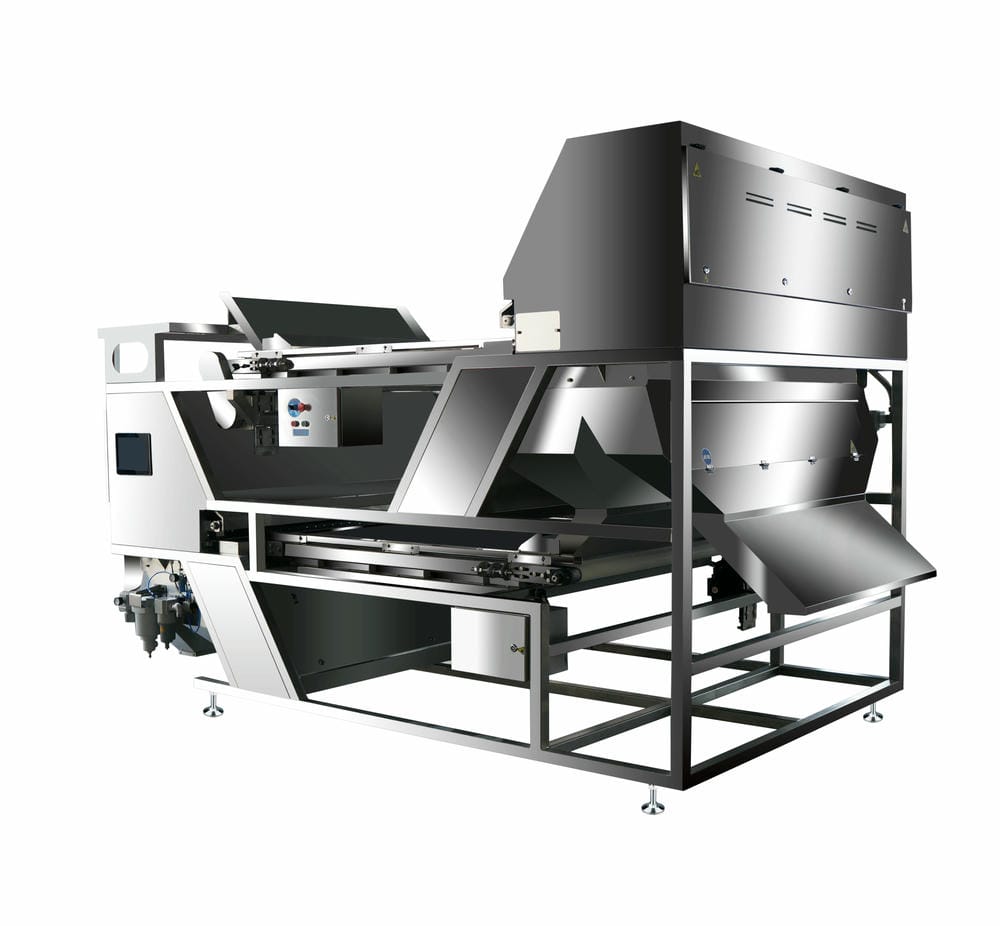Chute Type AI Sorting Machine
Belt Type AI Sorting Machine
What is AI Sorter
AI Sorter represents the next generation of intelligent color sorting machines that integrate artificial intelligence with advanced optical sensors. Unlike traditional color sorters, AI Sorters leverage deep learning algorithms to analyze material characteristics beyond simple RGB values, enabling unprecedented accuracy in industrial sorting applications. These machines exist in two primary configurations: chute-type and belt-type, each designed for specific material handling requirements while sharing the same core AI-driven technology.
The fundamental innovation of AI Sorters lies in their ability to dynamically improve sorting criteria through machine learning. As the system processes more materials, it continuously refines its recognition patterns for defects, colors, and material properties. This self-optimizing capability makes AI Sorters particularly valuable for complex sorting tasks where traditional methods would require constant manual adjustments to maintain accuracy.

How AI Sorter Works
AI Sorters combine sensors with neural networks to perform real-time material analysis at industrial speeds. When materials pass through the detection zone, multiple sensors capture comprehensive data including color, shape, texture, and even chemical composition through spectral analysis. The AI processor compares these parameters against learned patterns to make sorting decisions within milliseconds, activating precise air jets to separate unwanted particles.
The sorting process begins with material feeding, where products enter either through vibratory chutes (in chute-type models) or conveyor belts (in belt-type models). Advanced illumination systems ensure consistent lighting conditions for accurate detection, while the AI engine processes up to 5,000 images per second in some high-end models. This combination of speed and intelligence allows AI Sorters to achieve rejection accuracies exceeding 99.9% for many applications.
Application Scenarios
AI Sorters have transformed quality control processes across multiple industries. In food processing, they identify and remove defective grains, nuts, and fruits with unprecedented precision while simultaneously grading products by quality. Recycling facilities utilize their advanced recognition capabilities to separate complex material streams, including differentiating various plastic types or removing contaminants from glass cullet.
The mining industry benefits from AI Sorters' ability to analyze ore composition in real time, enabling on-site ore grading and waste rejection. Pharmaceutical manufacturers employ these systems to verify pill integrity and color consistency. As sustainability requirements grow, AI Sorters play an increasingly vital role in maximizing material recovery rates while minimizing waste.
AI-Powered Vision System
Our proprietary deep learning algorithms analyze multi material characteristics beyond traditional RGB values, achieving 99.9% sorting accuracy for complex materials like recycled plastics and specialty grains.
Dual Configuration Options
Choose between high-speed chute-type sorters for free-flowing materials or gentle belt-type systems for delicate products - both powered by the same advanced AI sorting engine.
Multi-Spectral Detection
Combines visible light, near-infrared (NIR), and laser sensors to identify defects based on color, texture, composition, and structural properties - perfect for food safety compliance and premium product sorting.
Self-Learning Capability
The machine continuously improves its recognition models through operational data collection, automatically adapting to new material varieties and defect patterns without manual recalibration.
Purchasing Guide
When selecting an AI Sorter, consider both your immediate sorting needs and potential future requirements. Chute-type models generally offer higher precision for smaller, free-flowing materials like grains or seeds, while belt-type systems better handle larger or irregularly shaped items. Evaluate the machine's learning capabilities - superior systems can develop new recognition criteria without requiring extensive reprogramming.
Assess the total cost of ownership rather than just purchase price, factoring in energy consumption, maintenance requirements, and potential productivity gains. Request material tests using your specific products to verify performance claims. Ensure the supplier provides comprehensive training and ongoing support, as AI systems often require different operational approaches than traditional sorters.
Maintenance Guide
Proper maintenance ensures long-term reliability and sorting accuracy for AI systems. Daily cleaning of optical components prevents dust accumulation that could affect detection quality. Regular calibration checks maintain sorting precision, with many modern systems incorporating automatic calibration routines. Monitor air system components including filters and dryers to protect sensitive valves from moisture and particulates.
Software maintenance proves equally important for AI Sorters. Regularly update the operating system and AI models to incorporate the latest improvements and security patches. Back up sorting parameters and learned patterns to prevent data loss. Schedule periodic professional inspections to verify all mechanical and optical components remain within specifications, as subtle degradation can gradually impact performance in ways the AI might compensate for without alerting operators.
Core Features and Advantages
AI Sorters provide several groundbreaking capabilities that outperform conventional color sorters. Their self-learning algorithms can distinguish subtle differences that human operators might miss, such as slight color variations in food products or minute structural defects in recycled materials. The systems maintain detailed sorting logs that help operators optimize production processes and trace quality issues back to their sources.
Operational efficiency represents another major advantage, with AI Sorters typically achieving 30-50% higher throughput than conventional machines while using less compressed air. The intelligent systems can automatically adjust sorting parameters based on material flow rates and contamination levels, reducing the need for constant manual supervision. Remote monitoring capabilities allow technicians to oversee multiple sorting lines from centralized locations.

Technical Specifications
Modern AI Sorters feature processing speeds ranging from 3 to 12 tons per hour depending on model and application, with sorting accuracies between 99.5% and 99.99%. They incorporate industrial-grade computing platforms with dedicated AI accelerators capable of performing billions of operations per second. Standard configurations include LED illumination systems with adjustable wavelengths, high-speed solenoid valves with response times under 5ms, and industrial touchscreen interfaces for system control.
Connectivity options typically encompass Ethernet, Wi-Fi, and industrial IoT protocols for integration with smart factory systems. Power requirements vary from 3kW for compact units to 15kW for large industrial systems. Both chute-type and belt-type models support material-specific configurations including specialized feeding systems, protective covers for dusty environments, and food-grade construction materials where required.
Specification Comparison
The following provides a brief comparison between the M1 model (representative of Chute Type AI Sorting Machines) and the B300 model (representative of Belt Type AI Sorting Machines).
| SPECIFICATION | M1 | B300 |
|---|---|---|
| Power | 1 KW | 2 KW |
| Capacity | 0.5-1.5 T/H | 1-3 T/H |
| Camera Number | TWO | TWO |
| Accuracy | 99.99% | 99.99% |
| Size (mm) | 950X1550X1600 | 2750X980X1530 |
| Weight | 350kg | 700kg |
| Sorting Mold | Color identification / Size identification / Edge identification / Texture identification / Shape identification | |
| Camera Pix | 5400 Pixel | |
| Ejector | Super-High Speed Matrix Ejectors | |
| Light Source | LED RGB three-primary color model lighting systems | |
| CCD Sensor | TOSHIBA Micron-sized superior HD RGB | |
| Touch Screen | HITACHI 10.4 inch operation screen system (Remote debugging after connecting to WIFI) | |